By Keith Austin
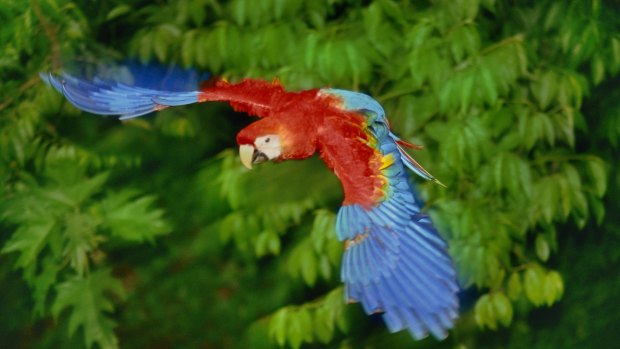
Scarlet macaw in flight.Credit: Getty Images
Many moons ago, as a callow youth, my best friend's father took us fishing. We sat on the edge of some god-awful, fish-free river for a week. Which just shows you how boring it was – we only went for the day.
So when the head guide tells us we're going fishing you can imagine how my heart sinks. Not just for me but for my fellow passengers – we might be deep in a remote corner of the Peruvian Amazon but given my record all the fish will be off somewhere slurping back a pisco sour or three.
I needn't have worried; the phrase "piranha-infested" isn't a cliche for nothing. Armed only with the sort of fishing equipment Huckleberry Finn would have recognised, we are soon balancing on a steel skiff and pulling piranhas out of the river as easily as a barman pulls pints.
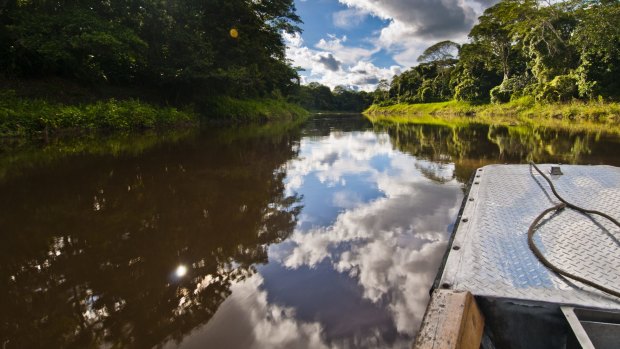
The bow of a touring skiff cruises along the calm waters of the Amazon.Credit: Getty Images
The bait is simply raw meat but after a while I'm starting to think we're catching a rare species of suicidal piranha, so keen are they to leap onto the hook. One, two, three, four … it's like the universe is making up for that day long ago.
Suicidal they may be but they're also surprisingly pretty with their flame-coloured bellies and silvery top halves. But beneath the beauty lies the beast, as Reni, our guide, demonstrates by gingerly pulling the fish's lips back to reveal the razor sharp gnashers at the root of its fearsome reputation as a flesh-stripper.
It's an image that returns to haunt the next day when we are invited to plunge into a murky green lake to swim with the pink dolphins that call these waters home. Piranhas, after all, can detect a tiny drop of blood in 200 litres of water. And do my toes in any way resemble raw meat?
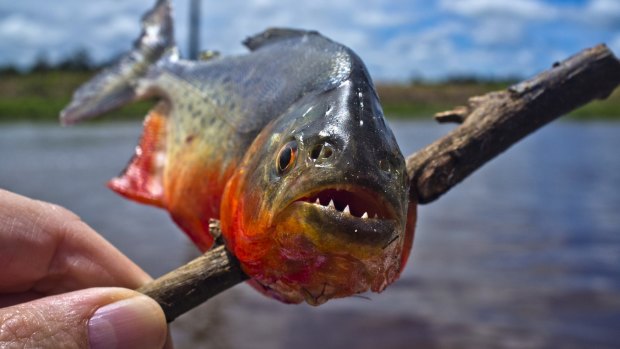
A freshly-caught piranha.Credit: Getty Images
We arrived at our luxury houseboat after a two-hour flight from the Peruvian capital, Lima, to Iquitos, a speck of civilisation in the far northeast of the country which has the unique boast of being the largest city in the world inaccessible by road.
From here it is another 90-minutes' drive south to Nauta, a tiny end-of-the-road port, through stygian streets dotted with ubiquitous tuk-tuk-style moto-taxis and the occasional brightly lit commercial chicken run (chook is a popular food hereabouts).
Our home for the next four nights is moored just offshore, its cheerful constellation of lights reflected in the Maranon River's still waters until disturbed by the skiffs that ferry across us and our luggage.
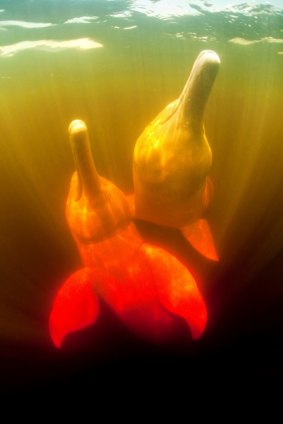
Pink River Dolphins, or Boto.Credit: Getty Images
Delfin Amazon Cruises has two ships – the ingeniously named Delfin I and the even more wackily named Delfin II – and we are on the second one, an elegant, 41-metre-long, 10-metre-wide houseboat with 18 suites which plies the waterways of the pristine Peruvian Pacaya Samiria National Reserve.
At more than 21,000 square kilometres, the reserve is the largest protected flooded forest in the world, a sodden region of lakes, rivers and overgrown creeks. It is also (we hope) chockful of wildlife. At least it should be; according to official estimates this is where 527 bird species, 102 mammal species, 69 species of reptiles, 58 species of amphibians and 269 fish species hang out.
After an excellent first-night dinner of heart of palm salad and grilled paiche (a prehistoric-looking local fish whose large scales have been used to make the centrepiece chandelier in the dining room) we retire to our airconditioned suites and fall asleep to the patter of a gentle rain and the faint throb of engines as the boat takes us deeper into the lush, fertile depths of Amazonia just 40 or so kilometres from the confluence where the Maranon and the Ucayali rivers meet to become the mighty Amazon.
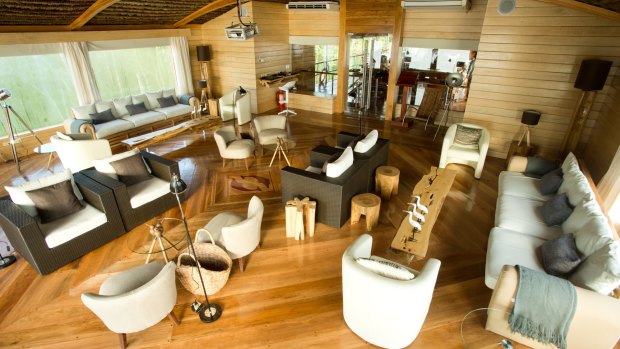
The Delfin II lecture room.
The next day dawns light grey. Pulling the curtains open reveals a wide, fast-flowing river peppered with the floating debris of branches and trees uprooted or felled by rising waters. A slim wooden skiff putts by, its rear-mounted engine biting into the muddy water and a woman crouching in the prow of the boat holding a bright blue umbrella against the light, gusting rain which is speckling the large picture windows of my cabin.
It doesn't bode well for the day's first activity – an 8am skiff exploration of a nearby tributary – but as we tuck into the bounteous buffet breakfast bulbous white clouds form and patches of blue sky appear between them.
As a first trip out into the backblocks of the Peruvian Amazon it's not too shabby. Yellow-bellied social flycatchers swoop around the boat, large dragonflies with glittering rainbow wings hover nosily around us, and bright blue kingfishers sit on broken branches and watch for swirls in the water which might be evidence of their next meal.
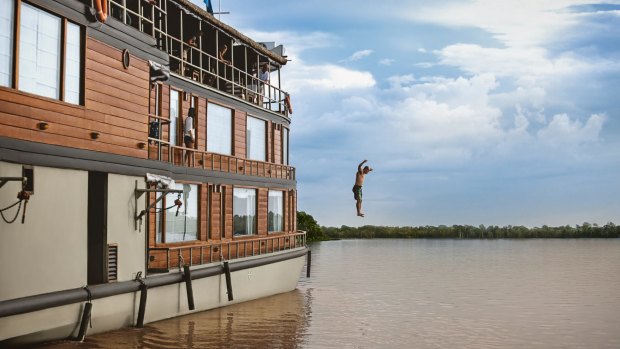
Taking the plunge.
Reni the guide gets excited when a small flock of macaws flaps overhead and cups an ear to get us to listen to the indignant 'Ow! Ow! Ow!' of parrots disturbed by the presence of a bird of prey. There are flashes of colour throughout the dense jungle, herons and egrets pose elegantly on vertiginous treetops and at one point a beautiful electric blue morpho butterfly flaps by, refusing to stay still long enough to be photographed.
It's both exciting and strangely somnambulistic, what with the close tropical warmth, the lap of water against the hull, the placid dapple of sunlight through trees, the melodic birdsong and the gentle whirr of a dozen cameras.
On the way back to the boat we come across the other skiff and discover they've already seen a large iguana. We trump this with the minuscule long-nosed bats we saw tucked underneath a fallen tree trunk but they pull out a three-toed sloth and win the trick. In the Great List of Peruvian Wildlife Challenge we are already bringing up the rear. Who knew there was such a thing as skiff envy?
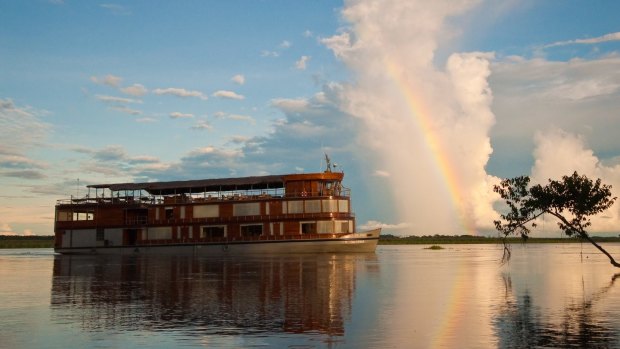
The Delfin II.
The days after this take on a familiar routine: early breakfast, lunch and three-course dinners interspersed with amazing once-in-a-lifetime adventures in the jungle. It's like being a hobbit in The Lord of the Rings: breakfast, black riders, second breakfast, ring wraiths, lunch, Mordor …
That afternoon we catch the first glimpses of one of the more astonishing creatures in the Amazon Basin: pink dolphins. We'd seen a few of your common-or-garden grey dolphins in the morning but I haven't mentioned it because, well, dolphin-schmolphin; if you haven't seen a pink one you haven't lived.
Frankly, seeing one of these astonishing mammals in the wild is pretty much akin to encountering a unicorn or some other mythological creature. At first it's hard to believe. You know that pink dolphins exist but the initial sighting is still a huge thrill. Suddenly our little craft is a miniature Pequod and we the sailors seeing Moby Dick for the first time. Without the running and the screaming and the death, obviously.
They are nothing short of magnificent, even if all we see of them is their surfacing back with its elongated dorsal fin and the occasional glimpse of the bulbous melon head and narrow snout.
Unlike ocean dolphins the pink river dolphins' vertebrae are not fused, enabling them to turn their heads 90 degrees each way and give you a dirty look should they so choose. It also helps them to manoeuvre around the roots of trees when the forests flood in the wet season. Their body colour is the result of having blood vessels close to the surface of very thin skin. This, says dolphinspedia, also means they blush a lot. And, yes, dolphinspedia.com is a thing.
To be honest, if we weren't supposed to be going kayaking this afternoon I'd stay here at what I'm coming to think of as pink dolphin corner.
The days pass, then, in a haze of happy happenstance as we stumble across capuchin, squirrel and spider monkeys, water snakes, egrets, ospreys, iguanas and yet more dolphins, both grey and pink. We also, finally, bag our fair share of three-toed sloths thanks to the eagle eyes of Reni, our guide.
Not so much a sloth whisperer as a sloth squinter, I'm betting this man can spot one of these shy, slow-moving creatures from the space station. "See? See there," he says, pointing at what looks to the rest of us like a maggot on a twig 300 metres away, "just past the grey tree on the right, three branches down".
And there it is, seen perfectly through borrowed binoculars or camera zoom, smiling gently down on us before sliding around to the other side of the tree trunk.
This is the sort of trip where memories aren't just made but seared into your brain – adventure piled upon exploits piled upon awe.
There are the wonderfully exuberant after-dinner shows by the staff – never before has La Bamba and El Condor Pasa been rendered so joyously, and without the need for a silly hat and a pan pipe.
Or there's the night we venture out just before sunset to search for caiman, those cheeky looking little cousins of the alligator, by spotting their glowing red eyes in a torch light, the whole thing performed to a background chorus of burping frogs.
These are the days, as Paul Simon sang in his 1986 hit The Boy in the Bubble, of miracle and wonder. Of kayaking in tropical downpours, happily soaked to the skin; of racing "home" in a skiff at top speed in the dark, safety glasses on and mouths closed against mosquitoes and bugs; of rainbows against thunderous grey storm clouds ripped by lightning; of tarantulas and termites that spit acid; of birds that sound like car alarms (the black fronted nunbird) and others whose cry sounds like they're shouting "Google" (the horned screamer).
On the final morning, loafing around on the breezy top deck, I talk to two passengers who are gazing contentedly at the passing scenery. Quite independent of each other they say: "Another day in paradise."
And, like all cliches, it's true.
LATAM Airlines operates daily from Sydney to Santiago, Chile, via Auckland, with onward connections to Lima or direct to Iquitos. Fares start at about $2259 but special offers are available for as little as $1499. Delfin's recommended flight departs Lima daily in the afternoon and arrives in Iquitos around 5pm. See latam.com.
There is no requirement for vaccinations going in to Peru but returning travellers will be asked for a valid yellow fever vaccination certificate at customs in Australia. See latam.com; smartraveller.gov.au.
CRUISING THERE
Delfin Amazon Cruises offer three and four night cruises from $US3000 a person in a twin cabin. Price includes all meals on board, national park entrance fees, all excursions and equipment, airport transfers (on recommended flights) and all beverages including local cocktails, house wines and beer. See delfinamazoncruises.com.
WHEN TO GO
The Amazon has two basic seasons: the flood (November to May) and the dry. In a typical year, there are 200 rainy days and it's always hot. There is no requirement for vaccinations going in to Peru but returning travellers will be asked for a valid yellow fever vaccination certificate at customs in Australia.
Keith Austin was a guest of Promperu.
Sign up for the Traveller Deals newsletter
Get exclusive travel deals delivered straight to your inbox. Sign up now.